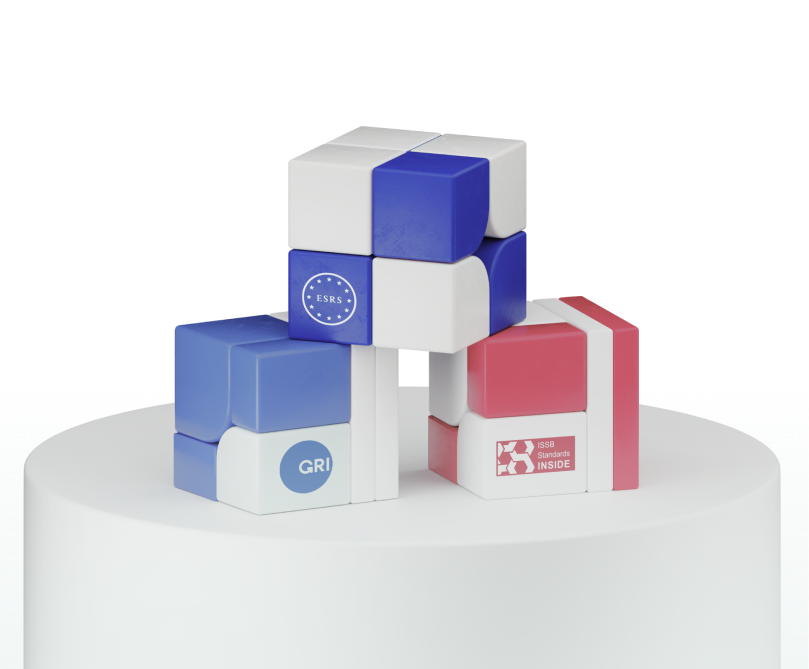Interoperability
Why it makes a real difference
Simplified reporting
Easily connect shared data across universal standards—no more duplicate work or manual fixes
More accurate data
Rely on a single, trusted source to keep your reporting consistent and reliable
Ready for change
Stay compliant and adapt quickly as regulations evolve—no need to start from scratch
Tailored reports
Create clear, focused reports that meet the specific needs of different audiences
Smarter use of time
Work more efficiently by using one dataset to cover multiple reporting requirements


Interoperability between ESRS, GRI, and ISSB
The ESRS (European Sustainability Reporting Standards) shares significant alignment with both GRI (Global Reporting Initiative)
and ISSB (International Sustainability Standards Board) frameworks.
Our platform leverages these alignments to provide data flow between multiple standards for consistency and compliance.
ESRS and GRI Interoperability
Many data points in ESRS overlap with those in GRI, allowing organizations to meet the requirements of both frameworks. Here are a few examples:

Greenhouse gas emissions
ESRS E1-6
Requires reporting on Scope 1, 2, and 3 GHG emissions.
GRI 305-1, 305-2, 305-3
Similarly addresses direct and indirect GHG emissions.
Solution
Our platform maps emissions data collected once to both ESRS and GRI requirements.

Employee diversity
ESRS S1-15
Focuses on workforce diversity metrics.
GRI 405-1
Examines diversity by gender, age group, and governance body representation.
Solution
Align diversity data with both ESRS and GRI to present consistent and accurate information.

Water and effluents management
ESRS E2-4
Requires reporting on water-related impacts.
GRI 303-1, 303-2
Covers water withdrawal and discharge management.
Solution
Consolidate water-related data to meet both frameworks’ requirements.
ESRS and ISSB Interoperability
The ESRS and ISSB frameworks also share a strong alignment, particularly in areas such as climate-related disclosures and financial impacts of sustainability. Key examples include:

Climate-related governance and strategy
ESRS E1-1
Requires reporting on climate-related governance and strategy.
ISSB S2-4
Focuses on governance and strategy for climate-related risks and opportunities.
Solution
Our platform centralises governance data, to meet both ESRS and ISSB standards.

Financial impact of sustainability
ESRS E1-9
Covers the financial effects of climate risks and opportunities.
ISSB S2-6
Requires disclosure of financial impacts of sustainability-related risks and opportunities.
Solution
Collect financial impact data once and map it across both frameworks.

Scope 1, 2, and 3 greenhouse gas emissions
ESRS E1-6
Requires reporting on Scope 1, 2, and 3 GHG emissions.
ISSB S2-8
Aligns with ESRS in covering these emissions comprehensively.
Solution
Unified data collection with European and international standards.
How our platform supports interoperability?
Pre-built mapping
Integrates interoperability indices.
Efficiency gains
Collect data once and apply it across multiple frameworks, eliminating redundancies.
Regulatory preparedness
Stay compliant with regulations and standards, adapting to new frameworks with ease.
Improved collaboration
Share consistent, high-quality data across teams and external stakeholders, for transparency and trust.
Why interoperability matters?
As global sustainability standards begin to align, making ESRS, GRI, and ISSB work together is more important than ever.
Our platform helps stay ahead by bridging European and International standards—so organization can:
Stay compliant with the needs of different stakeholders.
Increase transparency and make reporting more reliable.
Cut down on manual work and avoid duplication.
Thanks to our smart interoperability features, you can create consistent, efficient, and fully compliant reports across key frameworks.